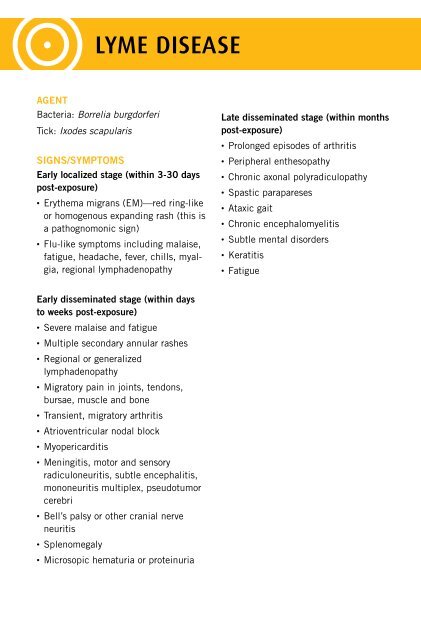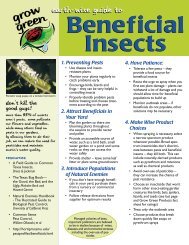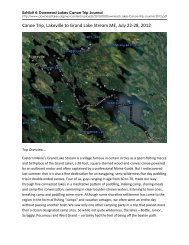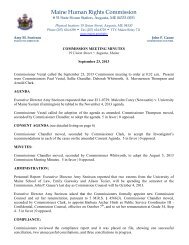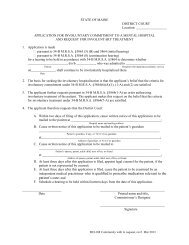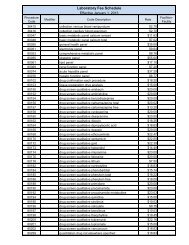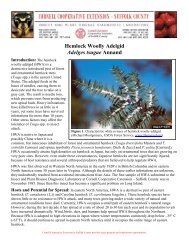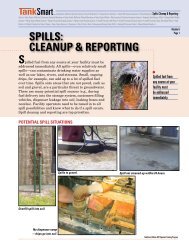TICK-BORNE DISEASES IN MAINE - Maine.gov
TICK-BORNE DISEASES IN MAINE - Maine.gov
TICK-BORNE DISEASES IN MAINE - Maine.gov
Create successful ePaper yourself
Turn your PDF publications into a flip-book with our unique Google optimized e-Paper software.
Lyme disease<br />
AGENT<br />
Labs<br />
Bacteria: Borrelia burgdorferi<br />
Tick: Ixodes scapularis<br />
Signs/Symptoms<br />
Early localized stage (within 3-30 days<br />
post-exposure)<br />
• Erythema migrans (EM)—red ring-like<br />
or homogenous expanding rash (this is<br />
a pathognomonic sign)<br />
• Flu-like symptoms including malaise,<br />
fatigue, headache, fever, chills, myalgia,<br />
regional lymphadenopathy<br />
Early disseminated stage (within days<br />
to weeks post-exposure)<br />
• Severe malaise and fatigue<br />
• Multiple secondary annular rashes<br />
• Regional or generalized<br />
lymphadenopathy<br />
• Migratory pain in joints, tendons,<br />
bursae, muscle and bone<br />
Late disseminated stage (within months<br />
post-exposure)<br />
• Prolonged episodes of arthritis<br />
• Peripheral enthesopathy<br />
• Chronic axonal polyradiculopathy<br />
• Spastic parapareses<br />
• Ataxic gait<br />
• Chronic encephalomyelitis<br />
• Subtle mental disorders<br />
• Keratitis<br />
• Fatigue<br />
Common Findings on Routine<br />
Laboratory Tests<br />
• Elevated sedimentation rate (generally<br />
with localized or early disseminated<br />
disease)<br />
• For cases of Lyme disease meningitis,<br />
CSF typically has a lymphocytic<br />
pleocytosis with slightly elevated<br />
protein levels and normal glucose<br />
levels<br />
Diagnostic Laboratory Criteria<br />
• Demonstration of diagnostic IgM (in<br />
first 6 weeks ONLY) or IgG antibodies<br />
in serum or cerebrospinal fluid. Due<br />
to high false-positive rates in both<br />
enzyme immunoassay (EIA) and<br />
immunoflourescence assay (IFA)<br />
tests, a two-tier testing protocol is<br />
recommended; a positive or equivocal<br />
EIA or IFA should be followed by<br />
a Western blot (preferred method)<br />
Limitations to Serologic Tests for<br />
Lyme Disease:<br />
• Serologic tests are insensitive during<br />
the first few weeks of infection.<br />
• In persons with illness > than 1 month,<br />
a positive IgM test alone is not<br />
recommended for determining current<br />
disease<br />
• Due to antibody persistence, single<br />
positive serologic test results can not<br />
distinguish between active and past<br />
infection and serologic tests can not be<br />
used to measure treatment response.<br />
• Due to their high sensitivity and low<br />
specificity, EIA and IFA tests may yield<br />
false-positive results due to crossreactivity<br />
with antibodies to commensal<br />
or pathogenic spirochetes, certain viral<br />
infections (e.g., varicella, Epstein-Barr<br />
virus), or certain autoimmune diseases<br />
(e.g., systemic lupus erythematosus).<br />
• Transient, migratory arthritis<br />
NOTE: Coinfection with B. microti and/or<br />
• Atrioventricular nodal block<br />
• Myopericarditis<br />
• Meningitis, motor and sensory<br />
radiculoneuritis, subtle encephalitis,<br />
mononeuritis multiplex, pseudotumor<br />
cerebri<br />
• Bell’s palsy or other cranial nerve<br />
neuritis<br />
A. phagocytophilum should be considered<br />
in patients who present with initial symptoms<br />
that are more severe than are commonly<br />
observed with Lyme disease alone,<br />
especially in those who have high-grade<br />
fever for more than 48 hours despite<br />
appropriate antibiotic therapy or who have<br />
unexplained leucopenia, thrombocytopenia,<br />
or anemia. Coinfection might also be<br />
• Splenomegaly<br />
considered in patients whose erythema<br />
• Microsopic hematuria or proteinuria<br />
migrans skin lesion has resolved but have<br />
persistent viral infection-like symptoms.


